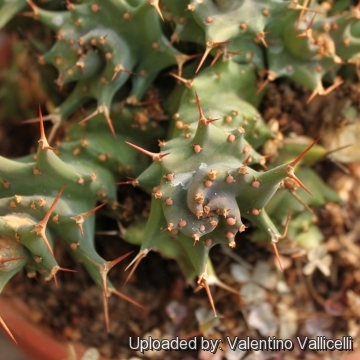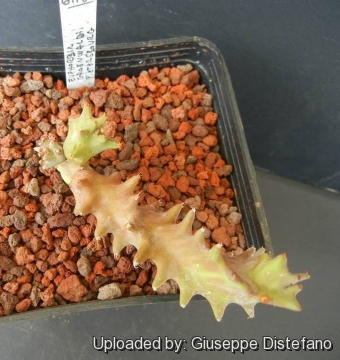




Your support is critical to our success.
- Encyclopedia of SUCCULENTS
- Encyclopedia Index
- Families
- Genera
- Species
- Euphorbiaceae
- Euphorbia
- Caudiciforms
Since 4 Aug 2013

Origin and Habitat: South Africa (Mpumalanga: hills around Pieterburg and Sand River Valley)
Altitude: 1100 - 1500 m asl.
Type locality: Few kilometers from Pietersburg on a stony hillside.
Habitat: It grows in sandstone and quartzite hills on extremely rocky and hard ground in Moist Mountain Bushveld vegetation with sparse Acacia scrub.
Synonyms:
- Euphorbia groenewaldii R.A.Dyer
Description: Euphorbia groenewaldii is a small spiny euphorbia topped off with 5-7 bizzare, twisted branches produced at ground-level from an underground caudex. The lax rosette of branches usually do not exceed 25 cm in diameter.
Root: Long fleshy tap root.
Caudex: Swollen, woody, more or less subterranean up to 20 cm long and 8 cm in diameter. This caudex is formed by the main stem merging into the thick, fleshy, tuberous root and is composed of both root and stem tissue, the transitional zone between these two organs being distinguished only with difficulty.
Branches: Up to 7 cm long, 3-angled, 2(-3) cm wide, dark green to purply, spirally twisted, angles with very prominent teeth to 1 cm long.
Spines shields: Not confluent.
Spines: Up to 1 cm long.
Stipular Spines: Minute.
Inflorescences: Cymes solitary, simple; peduncles stout, up to 1 cm long; Cyathia up to 7 mm in diameter; nectat glands oblong, yellow, just touching.
Fruit: Obtusely lobed, 8 mm in diameter. Sessile.
Seeds: Subglobose, smooth.
Bibliography: Major referencences and further lectures
1) “Fauna and flora”, Ed. 36-48 Transvaal Nature Conservation Division., 1980
2) Hermann Jacobsen “Abromeitiella to Euphorbia” Blandford Press, 1960
3) Alain Campbell White, Robert Allen Dyer, Boyd L. Sloane “The succelent Euphorbisae (southern Africa)” Abbey garden press, 1941
4) Urs Eggli “Illustrated Handbook of Succulent Plants: Dicotyledons” Volume 2. Springer, 2002
5) Dr. A. Rabson (Sth. Africa) “EUPHORBIA GROENEWALDII R. A. Dyer in Fl. Plants S.A. 1938” Ashingtonia Vol.1 - page 9.

Euphorbia groenewaldii Photo by: Valentino Vallicelli

Euphorbia groenewaldii Photo by: Valentino Vallicelli

Euphorbia groenewaldii Photo by: Giuseppe Distefano
The gallery now contains thousands of pictures, however it is possible to do even more. We are, of course, seeking photos of species not yet shown in the gallery but not only that, we are also looking for better pictures than those already present. Read More...
Cultivation and Propagation: Euphorbia groenewaldiiSN|21556]]SN|25150]] is cultivated as an ornamental, and is a particular favourite of succulent plant enthusiasts. Cultivation of this plant is the same as that for the other tuberous varieties of Euphorbia, (e.g. Euphorbia stellataSN|17359]]SN|17359]], Euphorbia deciduaSN|25150]]SN|21556]] etc.)
Growth rate: It is a slow growing species, but it it possible to increase the speed of growth to some extent by providing adequate amount of water, warmth, and fertilizer during the active growing season, but it’s susceptible to rotting if too wet and do not like a lot of water when they are on rest.
Soil and pots: It likes pots with generous drain holes, needs a very airy potting medium which mainly consists of non organic material such us clay, pumice, lava grit, and only a little peat or leaf-mould, seeing that the main trunk is planted with the majority of the roots below the caudex line. It's rare that it will use the upper third of its soil and often this area serves like a mulch or support for the stem.
Fertilization: Need a perfect fertilizer diet in summer. Use preferably a cacti and succulents fertilizer with high potassium content including all micro nutrients and trace elements or slow release fertilizer.
Exposure: This plant has an excellent heat tolerance, and need full sun to light shade exposures, it grows well even in full blasting sun, but can tolerate moderate shade, and a plant that has been growing in shade should be slowly hardened off before placing it in full sun as the plant will be severely scorched if moved too suddenly from shade into sun. The color of this plant is much more marked if grown in full sun.
Watering: Water regularly during the active growing season. No water should ever be allowed to stand around the roots. Keep almost completely dry in winter. However this spurge will tolerate dryness and can even thrives in poor, dry soils, but do better when grown in nutrient-rich soils with regular watering.
Hardiness: Some cold tolerance. This spurge has tolerated temperatures down to –6º C. However it can be difficult to get it to look its best without a good amount of heat and sun and so it is only really suited to the tropics (USDA Zones 9-12). It can be grown outdoors in frost-free climates.
Rot: Rot is only a minor problem with Euphorbias if the plants are watered and “aired” correctly. If they are not, fungicides won't help all that much.
Manteinance: Re-pot every two years and trim off the dead 'arms'.
Known hazards: The latex/sap is poisonous and can cause skin rash, itching and general discomfort, and they should be handled with caution, particularly when pruning.
Propagation: The plant can be reproduced by seeds or cuttings. The seedling is best left until it is larger as it will grow faster if the root is buried. The plant may be propagated by branch cuttings which will grow and flower. Usually cuttings will not form caudexes unless double cut. Once growth is strong, the top of the green shoot needs to be cut off again to force the plant to start a caudex. Some plant form a perfectly symmetrical caudex when grown from seed, but form distorted (but often more interesting) caudexes when grown from cuttings. If you remove an offset, remember to let it dry for some days, letting the wound heal (cuttings planted too soon easily rot before they can grow roots). Lay it on the soil and insert the stem end partially into the substrate. Try to keep the cutting somewhat upright so that the roots are able to grow downward. It is better to wash the cut to remove the latex.
| Your Actions | |
|---|---|
| Back to Euphorbia index | |
| Back to Euphorbiaceae index | |
 |
Back to Succulents Encyclopedia index |
Privacy stantement - Terms and conditions - How to cite - About us - Feedback - Donate



